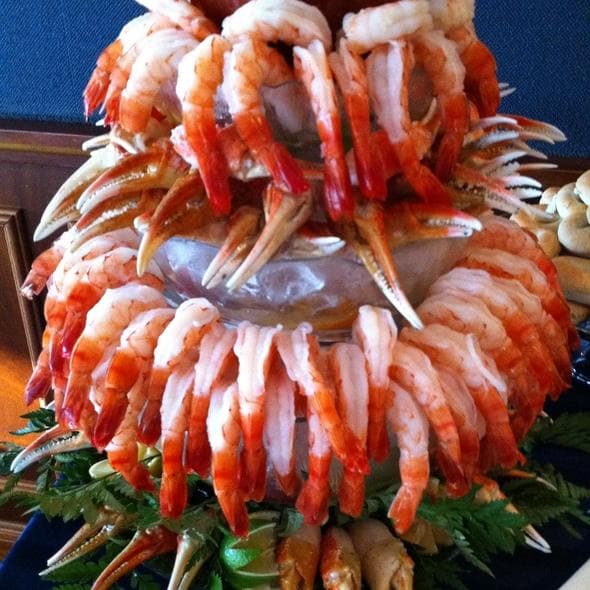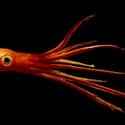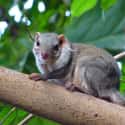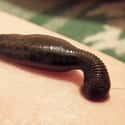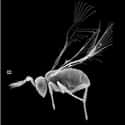-
(#4) Giant squid
- Architeuthis
In spite of the fact that a giant squid can reach up to 1,500 pounds, their brains only clock in at about .2 pounds. Even stranger, those brains are wrapped around the giant squid’s esophagus. The hole the squid’s esophagus runs through is only about .4 inches. Because of this, the animal is forced to shred its food into tiny bits to avoid giving itself brain damage.
Fortunately, the giant squid is doing okay for two big reasons. First, it doesn’t eat a lot. And second, it simply floats around until food wanders into its eye line, at which point it reaches out one of its giant sucker-covered tentacles and snatches its dinner.
In other words, it makes sense the brain and esophagus have a kind of symbiotic relationship within the giant squid, because what little thinking it does is related directly to its consumption of food. The giant squid hardly has a complex approach to hunting.
-
(#8) Sperm Whale
- Physeter macrocephalus
At an average of about 16 pounds, sperm whales have the largest brain of any living mammal. That might sound like a lot, but when you consider sperm whales can get up to 63 tons, it’s not super impressive.
In fact, scientists believe the sperm whale’s one-of-a-kind noggin was actually made for ramming other whales. The theory spawns from the sperm whale’s long history of sinking ships for no apparent reason. A sperm whale was the inspiration for Moby Dick.
Though the whale’s head is huge, most of a sperm whale’s cranium is composed of “two large, oil-filled organs stacked one on top of the other - the spermaceti organ on top, and another below it called the junk.” According to scientists, partitions in the connective tissue inside the junk actually helps reduce stress when the sperm whale uses its head to smash into stuff.
-
(#5) Tree Shrews Have The Highest Brain-To-Body Mass Ratio Of Any Mammal
Though it’s not always accurate, a lot of scientists still put a lot of faith in measuring intelligence by the ratio of brain mass to body mass. By that token, humans are actually fifth in the pecking order of intelligence. The mammal that scores the highest? The tree shrew.
That extra brain power has imbued in the tree shrew a positively weird assortment of abilities, like drinking fermented nectar without getting drunk, for example. They have also developed pretty extensive symbiotic relationships with several types of plants.
-
(#14) Cavalier King Charles Spaniel
The next time you need an argument in favor of visiting a pet rescue instead of buying from a breeder, consider the case of the poor Cavalier King Charles Spaniel. Thanks to years of inbreeding, the spaniel’s skull can actually be too small to accommodate the entirety of the cerebellum.
In addition to a series of medical problems, the issue typically manifests as the animal using its back leg to scratch the air (it’s aiming for the base of its neck.)
-
(#2) Leech
- Hirudinea
The internal structure of the average leech is divided into 32 equal segments. Each of those segments has its own brain. Technically each segment has one ganglia - a structure containing a number of nerve cells - that belongs to one 32-segment structure, but the distinction is moot in practice. The thing has 32 brains. The first four sections of the brain are dubbed the "anterior brain" and contains the leech's signature sucker.
The brain isn’t the only thing that leeches double-up on. They’ve also got a matching set of reproductive organs and nine pairs of testes. Another fun fact: leeches are considered hermaphrodites.
-
(#13) Wasp
The Megaphragma mymaripenne is a species of wasp. Don’t be fooled by the “mega” in its name, though. At just a fifth of a millimeter in length, Megaphragma mymaripenne is actually smaller than an amoeba (and it’s not even the smallest insect on record).
It is pretty miraculous, though. In spite of being legit pint-sized, this wasp has a fully formed set of eyes, wings, muscles, guts, and even a fully formed brain and nervous system. Scientists have long been in awe of the wasp’s nervous system, despite it only having a measly 7,400 neurons. By comparison, a honeybee’s nervous system has 850,000 neurons.
Still, even armed with that puny messaging system for its brain, it can fly, hunt, and do all the normal stuff a wasp does. Even crazier, most of its neurons don’t even have a nucleus, which means they shouldn’t even be able to function. And yet they do, and the species lives on, and scientists are totally stumped by it.
New Random Displays Display All By Ranking
About This Tool
The animal brain is a mysterious and magical organ. It is like a microbiological computer, dominating all the thinking and behavior of the owner. Differnt animal brains have different shapes and functions, some are just a small cluster of nerve cells, while others are as complex as a human brain. For example, the spider's brain can overflow to its own legs, while the sea squirt continuously digests its own brain during its growth.
There are a variety of strange animals in the animal kingdom that have fascinated mankind. Over the centuries, with the advancement of science, many mysterious animal brains have gradually become known. The random tool introduced 14 incredibly fascinating animal brains.
Our data comes from Ranker, If you want to participate in the ranking of items displayed on this page, please click here.

